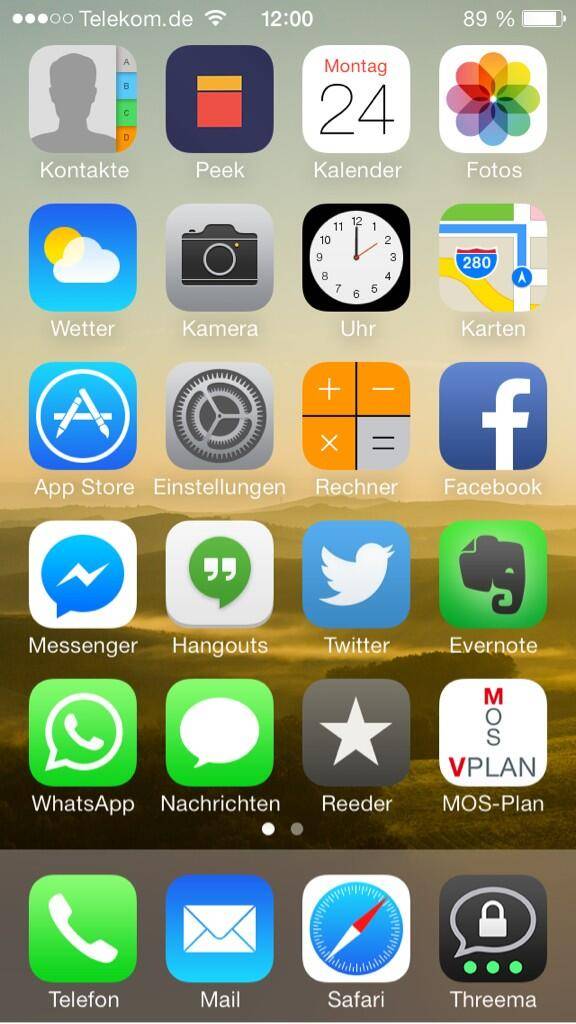Apple still reigns supreme on iOS homescreens—at least in the U.S.—but a host of Trojan Horses have been cropping up recently. Chief among them? Facebook and its family of apps.
Owning The Homescreen
It’s not surprising that Apple’s first-party apps would dominate iOS homescreens. After all, like Microsoft’s Windows, most users are not sophisticated or ambitious enough to seek out an alternative to a platform’s default apps, even when they’re demonstrably better. It took the European Commission to force Microsoft to give its Windows users a real choice in browsers.

In mobile, the EC isn’t needed. Not when we have Facebook.
According to new data from Betaworks, which analyzed the homescreens of 1,000 iOS users, nearly 69% of homescreens had a Facebook app on them (Facebook, Messenger, Instagram or Pages). That number goes up to nearly 81% if we include Whatsapp, Facebook’s most recent acquisition.
While Facebook completely bombed with its Facebook Home application layer and the Poke app, it has done remarkably well with its core social app, as well as its string of acquisitions, including Instagram.
As it stands, then, Facebook dominates the iOS experience. The more users choose messaging as their primary communication medium on iPhones, Apple may find itself scrambling to remain center stage on iOS. After all, iOS users are starting to install non-Apple messaging apps on their homescreens at a steady clip:
- Facebook Messenger (14%)
- Whatsapp (12%)
- Snapchat (11%)
- Path (5%)
- Groupme (4.7%)
- HipChat (2.6%)
- Line (1.5%)
- Viber (1%)
- Kik (0.5%)
In email, the numbers are actually worse for Apple. Betaworks found 50% of people who have a mail app on their homescreens have a non-Apple mail app. For task-related apps, that number grows to 57%, and the same trend follows suit with non-Apple calendars (46%), weather (44%) and maps (54%). Apple isn’t building the best apps, and users are starting to install alternatives and move them onto their homescreens.
What About Google?
Google, for its part, finds its way onto 62% of iOS homescreens—and not just once.
See also: Android Or iOS Dominating Tablets? Developer Economics Has The Answer
The median Google user has two Google apps on their homescreen. Google Maps, perhaps unsurprisingly, is the biggest hit, claiming 42% of homescreens. But that’s about the end of the good news for Google. As Betaworks found, after Google Maps the next most popular Google apps are YouTube (17%) and Chrome (17%). Google+? Only 8% of users bothered to include it on their homescreens.
Even so, “Google data underpins a lot of core experiences on mobile devices.” This is certainly true of my mobile usage: Even though I use Apple’s stock Mail, Calendar and Contacts apps, all of the data is fed from Google. The same is true of Mailbox, which surprisingly made it onto 25% of Betaworks’ sample—most of these users rely on Gmail IMAP.
Does the app matter if you own the data? Probably not. But in the case of Facebook, it owns both. The question is whether it can extend its relevance so we could invest more of our personal data in Facebook instead of Google services. For now, that seems like a long shot.
Other Facts And Figures
A few other salient points from Betaworks’ analysis:
- 14% of people have banished Apple’s built-in phone app from their iOS homescreens. Calling friends? That’s so 1900s.
- 65% of people have Safari on their homescreen, compared to Chrome (18%) and Opera Mini (0.5%). For 7% of people the browser is so important, they have both. For almost 10% of users, their homescreen contained no browser at all.
- 63% of people have the Apple Camera app on their homescreen.
- Evernote shows up on 24% of homescreens; Foursquare? 23%. AOL, Amazon and Pinterest had negligible shares.
- Microsoft’s apps showed up on exactly 0% of user homescreens. Microsoft won’t survive if it depends on owning the complete mobile experience, simply because so few people run Windows on their phones.
Granted, the sample is skewed toward Twitter users that knew about the study: Betaworks sampled 1,000 users who had tweeted their homescreen with the hashtag #homescreen2014.
But if Facebook continues to claim such a high percentage of homescreens, it will also claim an increasingly large chunk of mobile users’ time. An average American spends about 37 minutes using social media each day, with most of that time on Facebook and a full 60% of it on mobile devices. So as that number grows, Apple’s iOS may simply become a gateway to Facebook. For some, it already is.
Right image by Domenik on Twitter









